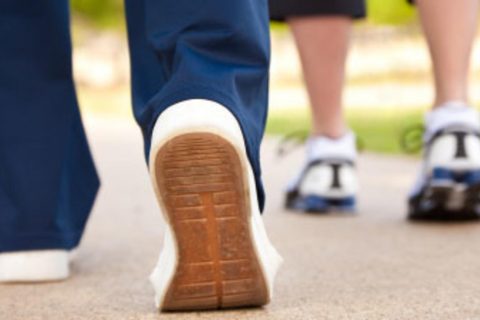Posted by Rachel Dolhun, MD,
Making Strides for Walking and Balance Problems

We don’t typically think much about walking or keeping balance unless we have trouble with these activities. That’s because we don’t have to think about them. Our brains automatically coordinate our bodies to move steadily. Parkinson’s can interrupt these automatic connections and cause walking and balance problems, especially in people who live with the disease for many years. People often walk more slowly and shuffle (unintentionally drag their feet) and sometimes stoop forward a bit. Freezing, the temporary inability to move, also may occur with progressing disease. Walking changes and freezing can lead to falls, limit the desire to be out in public with friends or make it unsafe to live at home alone.
These symptoms are, unfortunately, challenging to treat. Current Parkinson’s medications may help somewhat, but surgical therapies such as deep brain stimulation (DBS) don’t typically offer much relief and may even worsen balance. Effective treatment usually involves regular exercise as well as physical or occupational therapy. While any exercise is good, walking, yoga and tai chi are especially helpful. Physical and occupational therapists can recommend an appropriate exercise regimen and design programs to improve walking and balance, lessen or prevent falls, and allow you to do daily activities more easily and safely. Therapists also can suggest ways to avoid freezing and cues to get unstuck. Cues can be visual (a laser beam to step over); auditory (a metronome or hummed tune); touch (a tap from another person); or physical movement (marching or shifting weight between the feet).
Building on these treatment strategies, MJFF is funding unconventional therapies to reduce or prevent freezing and falls. These include gadgets that could detect freezing and prompt movement — socks and an in-shoe device that vibrate; a wearable system that makes a sound; and a headset that gives visual cues (such as stripes on the ground) when needed. Rehabilitation programs also are targeting walking, balance and freezing — one combines cues with daily exercise to lessen symptoms and another teaches specific footsteps to regain balance and avoid falls. Innovative contraptions are helping people live better lives with these symptoms — a wearable airbag inflates with falls to prevent injury and a lightweight robotic device encourages bigger steps for easier walking. While they may sound like science fiction, these out-of-the-box therapies are practical solutions for symptoms that can make daily life impractical.
Source: https://www.michaeljfox.org/news/making-strides-walking-and-balance-problems
